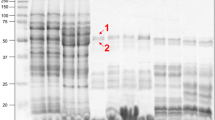Abstract
This work was aimed at showing the capacity of selected sourdough lactic acid bacteria to hydrolyze wheat and rye allergens. Hydrolysis was investigated after wheat sourdough fermentation and after treatment of wheat and rye sourdough breads with pepsin, trypsin and pancreatin, which mimicked the digestive process. As shown by immunoblotting with sera from allergic patients, wheat sourdough fermentation caused the disappearance of some IgE-binding proteins (albumins/globulins and gliadins mainly) with respect to the chemically acidified dough used as the control. The IgE-binding protein profile of wheat and rye sourdough breads differed from those of baker's yeast breads. The signals of the IgE-binding proteins contained in the sourdough breads disappeared after in vitro digestion with pepsin, trypsin and pancreatin. The same effect by digestive enzymes was not found for baker's yeast breads which showed persistent IgE-binding proteins. As shown by ELISA inhibition assays, the presence of IgE-binding low molecular weight proteins/peptides in sourdough breads significantly decreased with respect to baker's yeast breads. Proteolytic activity by selected sourdough lactic acid bacteria may have an importance during food processing to produce pre-digested wheat and rye dough which contains IgE-binding proteins degradable by digestive enzymes.





Similar content being viewed by others
References
Kay AB (2001) J Med 344:30–37
Kay AB (2001) J Med 344:109–113
Sampson HA, Sicherer SH, Birnbaum AH (2001) Gastroenterology 120:1026–1040
Nowak-Wegrzyn A, Conover-Walker MK, Wood RA (2001) Arch Pediatr 155:790–795
Schafer T, Bohler E, Ruhdorfer S, Weigi L, Wessner D, Heinrich J, Filipiak B, Wichmann HE, Ring J (2001) Allergy 56:1172–1179
Johansson SG, Hourihane JO, Bousquet J, Bruijnzeel-Coomen C, Dreborg S, Haahtela T, Cowalski ML, Myjind N, Ring J, van Cauwenberge P, van Hage-Hamsten M, Wuthrich B (2001) Allergy 56:813–824
Palosuo K, Alenius H, Varjonen N, Kalkkinen N, Reunala T (2001) Clin Exp Allergy 31:466–473
Battais F, Pineau F, Popineau Y, Aparicio C, Kanny G, Guerin L, Moneret-Vautrin DA, Denery-Papini S (2003) Clin Exp Allergy 33:962–970
Singh J, Blundell M, Tanner G, Skerritt J (2001) J Cereal Sci 34:85–103
Varjonen E, Vainio E, Kalimo K (1997) Clin Exp Allergy 27:162–166
Weiss W, Vogelmeier C, Gorg A (1993) Electrophoresis 14:805–816
FAO (Food and Agriculture Organization, Rome, Italy) (1998) FAOSTAT Statistical database. http://faostat.fao.org/faostat/
Shewry PR, Parmar S, Milfin BJ (1983) Cereal Chem 60:1–6
Bischoff S, Crowe SE (2005) Gastroenterology 128:1089–1113
Garcìa-Casado G, Armentia A, Sànchez-Monge R, Malpica JM, Salcedo G (1996) Clin Exp Allergy 26:428–435
International Union of Immunological Societies (2005) Allergen Nomenclature Subcommittee. http://www.allergen.org
Baldo BA, Wringley CW (1978) Clin Allergy 8:109–124
Ortolani C, Ispano M, Scibilia J, Pastorello EA (2001) Allergy 56:5–8
Astwood DJ, Leach JN, Fuchs RL (1996) Nat Biotechnol 14:1269–1273
Davis PJ, Smales CM, James DC (2001) Allergy 67:56–60
Di Cagno R, De Angelis M, Auricchio S, Greco L, Clarke C, De Vincenzi M, Giovannini C, D'Archivio M, Landolfo F, Parrilli G, Minervini F, Arendt E, Gobbetti M (2004) Appl Environ Microbiol 70:1088–1096
Di Cagno R, De Angelis M, Lavermicocca P, De Vincenzi M, Giovannini C, Faccia M, Gobbetti M (2002) Appl Environ Microbiol 68:623–633
Bindslev-Jensen C (2004) Allergy 56:75–77
Simonato B, Pasini G, Giannattasio M, Peruffo ADB, De Lazzari F, Curioni A (2001) J Agric Food Chem 49:5668–5673
Simonato B, Pasini G, De Zorzi M, Vegro M, Curioni A (2004) Ital J Food Sci 16:151–163
Laemmli UK (1970) Nature 227:680–685
Bradford MM (1976) Anal Biochem 72:248–254
Pasini G, Simonato M, Giannattasio M, Peruffo ADB, Curioni A (2001) J Agric Food Chem 49:2254–2261
Vermeirssen V, Van Camp J, Devos L, Verstraete W (2003) J Agric Food Chem 51:5680–5687
Curioni A, Santucci B, Cristaudo A, Canistraci C, Pietravalle M, Simonato B, Giannattasio M (1999) Clin Exp Allergy 29:407–413
Diaz-Perales A, Blanco C, Sanchez-Monge R, Varala J, Carrello T, Salcedo G (2003) J Allergy Clin Immunol 112:1002–1007
Church FC, Swaisgood HE, Porter DH, Catignani GL (1983) J Dairy Sci 66:1219–1227
SAS/STAT (1985) Guide for personal computers, vol. 5. SAS Institute, Cary, NC
Tazikawa T, Arakawa H, Tokuyama K, Morikawa A (2001) Int Arch Allergy Immunol 125:51–56
Mittag D, Niggermann B, Sander I, Reese I, Fiedler EM, Worm M, Vieths S, Reese G (2004) Mol Nutr Food Res 48:380–389
Gobbetti M, De Angelis M, Corsetti A, Di Cagno R (2005) Trends Food Sci Technol 16:57–69
Crespo JF, Rodriguez J (2003) Allergy 58:98–113
von der Weid T, Ibnou-Zekri N, Pfeifer A (2002) Dig Liver Dis 21:25–28
Macdougall CF, Cant AJ, Colver AF (2002) Arch Dis Child 86:236–239
Helm RM (2004) Curr Opin Allergy Clin Immunol 4:125–129
ILSI Europe Session (2004) In: 9th international symposium on immunological, chemical and clinical problems of food allergy, Budapest, Hungary, 18–21 April 2004
Acknowledgements
The authors thank Dr. Enrico Scala (Department of Onco-Immuno-Dermatology, IDI-IRCCS, 00167 Rome, Italy) for helpful discussion and Dr. Paola A.M. Loguercio (Dipartimento di Biochimica e Biologia Molecolare, University of Bari, 70126 Bari, Italy) for immunological analyses.
Author information
Authors and Affiliations
Corresponding author
Rights and permissions
About this article
Cite this article
Rizzello, C.G., De Angelis, M., Coda, R. et al. Use of selected sourdough lactic acid bacteria to hydrolyze wheat and rye proteins responsible for cereal allergy. Eur Food Res Technol 223, 405–411 (2006). https://doi.org/10.1007/s00217-005-0220-x
Received:
Revised:
Accepted:
Published:
Issue Date:
DOI: https://doi.org/10.1007/s00217-005-0220-x




